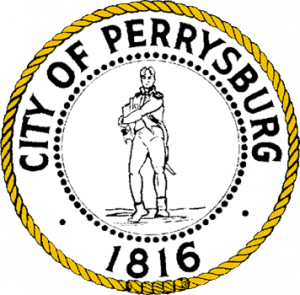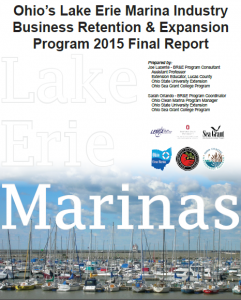The City of Perrysburg drains into three watersheds at the Hydrologic Unit Code (HUC) 12 scale—Grass Creek Diversion (HUC 04000090901), Grassy Creek (HUC 04000090902), and Crooked Creek (HUC 0409000090903)—which feed into the Maumee River and, subsequently, western Lake Erie. This area was identified by Ohio Sea Grant and Illinois-Indiana Sea Grant as an ideal location to hold a Tipping Points Planner (TPP) workshop. Through collaboration with Reveille, a local planning consultancy, Perrysburg, Ohio was identified as a potential community partner because the city is in the initial stages of preparing a comprehensive plan update.

In total, over 55 people participated in the workshop sessions. Ohio Sea Grant, Reveille, and the City of Perrysburg led the development of a steering committee which included key stakeholders from city departments, elected officials, and the public, as well as representatives from the City of Toledo, relevant state agencies, and Wood County. The steering committee held an initial meeting on August 13, 2018 in Perrysburg, Ohio to discuss goals for the workshop series and to identify additional planning considerations that may fall outside of the purview of the Tipping Point Planner. The steering committee also identified three key focus areas for the workshop: Land Use Planning and Open Space, Green Infrastructure and Stormwater, and Nutrients and Food Webs.
The Tipping Point Planner workshop was held to support Perrysburg’s comprehensive plan update by investigating water quality issues tied to topics listed above. A public visioning session, technical tipping points data and breakout session, and an action planning workshop were held from August 13 to August 15, 2018 at Perrysburg’s City Administration Building and Way Public Library. All meetings were open the public.
During the visioning session, participants were asked a series of questions to identify community characteristics and to understand how the public values natural resources in the Perrysburg area. Participants also discussed assets and opportunities related to the three key topics described above.
During the second meeting, participants received in-depth presentations on nutrient loading, green infrastructure, and land use issues in the region. Researchers from Michigan State University, University of Michigan, and Purdue University who developed the models forming the foundation of TPP presented, discussed the data, interpretations, and took questions from those in attendance.
The final meeting was an action planning session held on August 15 in which participants reviewed best management practices for watershed management using TPP. Through a facilitated discussion, action steps were identified that combined ideas developed during the previous visioning session with locally generated goals and TPP best management practices. The results comprise the final outcome of the workshop, an account of public input on land use and water quality, and a set of community based actions that incorporate best practices for addressing community water quality and quantity challenges through a comprehensive plan.
The community visioning session was facilitated by Ohio Sea Grant and Illinois-Indiana Sea Grant facilitators. The team employed a framework called PESTLE, which is used to consider a wide range of topics from business decisions to natural resource management initiatives. The strength of this approach is that participants are encouraged to think from six perspectives: Political, Economic, Social, Technological, Legal, and Environmental.

In this session, the PESTLE framework was coupled with the SOAR (Strengths, Opportunities, Aspirations, Results) method of appreciative inquiry. By focusing on strengths, assets, and opportunities, within the key topic areas of Land Use Planning and Open Space, Green Infrastructure and Stormwater, and Nutrients and Food Webs, program participants were able to identify what strengths exist in the community as well as what opportunities may be possible based on their existing assets. As the workshop progressed, participants rotated between table topics and were able to provide input on all of the workshop’s three key topic areas.

In the second meeting, the steering committee and interested individuals from the earlier community visioning session were able to choose one of the three key workshop topics to investigate using the Tipping Point Planner (TPP) Decision Support System. In a facilitated session, participants were guided through a series of maps within the TPP, and were able to manipulate various parameters within the watershed related to nutrient loads, time, and land use. This provided an opportunity for participants to visualize how changes in their watershed related to land use and nutrient loading would affect not only water quality in their local streams and rivers, but also the Lake Erie food web. A structured discussion was facilitated based on questions developed for each of the program’s three key topic areas.
Program participants engaged in a final facilitated discussion centered on identifying action strategies for each topic area. Each group was asked to identify or generate three to five goals using the community input received from the previous community vision session as well as the data and maps provided within the TPP system. Participants were facilitated through a series of questions that assisted in identifying appropriate goals and action strategies in the TPP system. Each goal was accompanied by Best Management Practices including sample ordinances, plans, community practices, incentives, and education options that were chosen by the group, and which are included in the Appendix of this report. Responsible parties, timelines and action items were also developed.
The process documented in the final report reflects in-depth public engagement with the residents and civic leadership in Perrysburg, Ohio on land use planning, stormwater, and nutrient loading issues. Participants engaged with forecasting models and provided their vision for the future. Finally, the group selected goals and strategies to work toward implementation of its vision.
The process is not over; as shown in the final report, there are many things left to be developed and decided. It is the hope of Ohio Sea Grant and Illinois-Indiana that the community continue to collaborate on the development of their comprehensive plan and that it be inclusive or informed by the contents of this final report. Example strategies and ordinances—as well as sample plans—can be found in the appendix of the final report. These resources include digital links to websites, documents, and other tools to help establish these strategies for Perrysburg and the surrounding area.
Find more information on Tipping Point Planner here.
Visit the previous Tipping Point Planner blog article here.
View final Perrysburg, Ohio report and appendices here.
 Joe Lucente is an Associate Professor and Extension Educator, Community Development, Ohio Sea Grant College Program and OSU Extension.
Joe Lucente is an Associate Professor and Extension Educator, Community Development, Ohio Sea Grant College Program and OSU Extension.
.






 Recognizing the importance of the agri-business industry, the Ohio Sea Grant College Program and Ohio State University Extension partnered with Lake County organizations to carry out a Business Retention and Expansion (BR&E) Program. Local partners included: the Lake County Soil and Water Conservation District, Lake County Development Council and Ohio Farm Bureau. As a result of this local applied research effort, the local partners and other community leaders are better able to assist ag-focused businesses in the area to achieve their growth objectives and to improve the overall business environment for Lake County’s agri-business industry.
Recognizing the importance of the agri-business industry, the Ohio Sea Grant College Program and Ohio State University Extension partnered with Lake County organizations to carry out a Business Retention and Expansion (BR&E) Program. Local partners included: the Lake County Soil and Water Conservation District, Lake County Development Council and Ohio Farm Bureau. As a result of this local applied research effort, the local partners and other community leaders are better able to assist ag-focused businesses in the area to achieve their growth objectives and to improve the overall business environment for Lake County’s agri-business industry.


 Are leaders born or are they made? While the philosophers debate that question, consider this: For over a decade, Extension and the Ohio Sea Grant College Program have partnered with the Toledo Regional Chamber of Commerce to provide training focused on leadership skill development to more than 300 aspiring, new and experienced public officials.
Are leaders born or are they made? While the philosophers debate that question, consider this: For over a decade, Extension and the Ohio Sea Grant College Program have partnered with the Toledo Regional Chamber of Commerce to provide training focused on leadership skill development to more than 300 aspiring, new and experienced public officials.